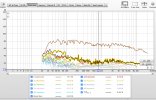Marc v E
Major Contributor
Hi all,
Long overdue but finally done! I managed to measure my speakers with Rew.
I measured using a umik1 microphone, in room, with the umik at my listening position. I don't use subwoofers or any eq.
The first picture is the response with 1/24 smoothing applied; the second the raw result and the third the response plus harmonic distortion and noise. (The noise floor in the 3rd picture is highlighted in yellow because I clicked on it before taking the screenshot.)



Long overdue but finally done! I managed to measure my speakers with Rew.
I measured using a umik1 microphone, in room, with the umik at my listening position. I don't use subwoofers or any eq.
The first picture is the response with 1/24 smoothing applied; the second the raw result and the third the response plus harmonic distortion and noise. (The noise floor in the 3rd picture is highlighted in yellow because I clicked on it before taking the screenshot.)



Last edited:




